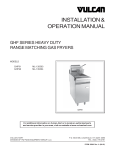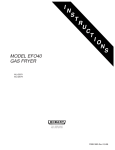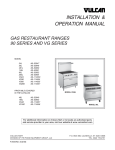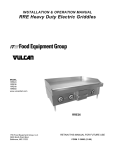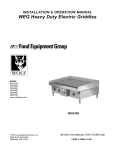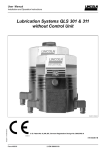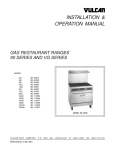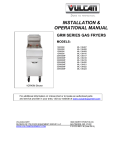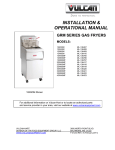Download Vulcan-Hart ML-135503 Specifications
Transcript
INSTALLATION & OPERATION MANUAL GHF SERIES HEAVY DUTY RANGE MATCHING GAS FRYERS MODELS GHF91 GHF90 ML-135503 ML-135504 GHF91 For additional information on Vulcan-Hart Company or to locate an authorized parts and service provider in your area, visit our Web site at www.vulcanhart.com VULCAN-HART COMPANY, P.O. BOX 696, LOUISVILLE, KY 40201-0696, TEL. (502) 778-2791 FORM 35609 (09-03) IMPORTANT FOR YOUR SAFETY THIS MANUAL HAS BEEN PREPARED FOR PERSONNEL QUALIFIED TO INSTALL GAS EQUIPMENT, WHO SHOULD PERFORM THE INITIAL FIELD START-UP AND ADJUSTMENTS OF THE EQUIPMENT COVERED BY THIS MANUAL. POST IN A PROMINENT LOCATION THE INSTRUCTIONS TO BE FOLLOWED IN THE EVENT THE SMELL OF GAS IS DETECTED. THIS INFORMATION CAN BE OBTAINED FROM THE LOCAL GAS SUPPLIER. IMPORTANT IN THE EVENT A GAS ODOR IS DETECTED, SHUT DOWN UNITS AT MAIN SHUTOFF VALVE AND CONTACT THE LOCAL GAS COMPANY OR GAS SUPPLIER FOR SERVICE. FOR YOUR SAFETY DO NOT STORE OR USE GASOLINE OR OTHER FLAMMABLE VAPORS OR LIQUIDS IN THE VICINITY OF THIS OR ANY OTHER APPLIANCE. WARNING IMPROPER INSTALLATION, ADJUSTMENT, ALTERATION, SERVICE OR MAINTENANCE CAN CAUSE PROPERTY DAMAGE, INJURY OR DEATH. READ THE INSTALLATION, OPERATING AND MAINTENANCE INSTRUCTIONS THOROUGHLY BEFORE INSTALLING OR SERVICING THIS EQUIPMENT. IN THE EVENT OF A POWER FAILURE, DO NOT ATTEMPT TO OPERATE THIS DEVICE. © VULCAN-HART COMPANY, 2003 –2– TABLE OF CONTENTS GENERAL .............................................................................................................................................4 INSTALLATION ....................................................................................................................................4 Unpacking .................................................................................................................................4 Location .....................................................................................................................................4 Installation Codes and Standards ............................................................................................5 Assembly ...................................................................................................................................5 GHF Series Fryers - Battery Type (Heavy Duty Style) .........................................................6 Gas Connections ......................................................................................................................6 Testing the Gas Supply System ..............................................................................................7 Leveling the Fryer .....................................................................................................................7 Flue Connections ......................................................................................................................7 OPERATION .........................................................................................................................................8 Controls .....................................................................................................................................8 Before First Use ........................................................................................................................8 Adding Liquid Frying Compound ..............................................................................................8 Lighting the Pilot ........................................................................................................................9 Turning the Fryer On ................................................................................................................9 Turning the Fryer OFF ..............................................................................................................9 High Limit Device .................................................................................................................... 10 Daily Filtering ...........................................................................................................................10 Frying Compound Maintenance .............................................................................................10 Cleaning ...................................................................................................................................11 MAINTENANCE ..................................................................................................................................12 Vent .......................................................................................................................................... 12 Service and Parts Information ................................................................................................12 –3– Installation, Operation and Care of MODEL GHF91 GAS FRYERS PLEASE KEEP THIS MANUAL FOR FUTURE REFERENCE GENERAL Vulcan fryers are produced with quality workmanship and material. Proper installation, usage and maintenance of your fryer will result in many years of satisfactory performance. Standard equipment on the fryer includes 6" (15 cm) adjustable legs, a lift-off backsplash, twin baskets and a stainless steel fry tank. Optional accessories available include extra twin baskets, a stainless steel tank cover, a large single basket, timer, less-legs base, and a quick-disconnect gas hose. Thoroughly read this entire manual and carefully follow all of the instructions provided. INSTALLATION Before installing, verify that the type of gas supply (natural or propane) agree with the specifications on the rating plate located on the inside of the fryer door panel. If the supply and equipment requirements do not agree, do not proceed with the installation. Contact your dealer or Vulcan-Hart Company immediately. The fryer must be restrained with adequate ties to prevent tipping when installed in order to avoid the splashing of hot liquid. UNPACKING This fryer was inspected before leaving the factory. The transportation company assumes full responsibility for safe delivery upon acceptance of the shipment. Immediately after unpacking, check for possible shipping damage. If the fryer is found to be damaged, save the packaging material and contact the carrier within 15 days of delivery. Carefully unpack fryer and place in a work-accessible area as near to its final installed position as possible. Do not use the fryer door or its handle to lift or move the fryer. The crumb tray, backsplash and two fryer baskets are packed in the fryer. LOCATION The equipment area must be kept free and clear of combustible substances. When installed, minimum clearance from combustible construction must be 6" (15 cm) at the sides and 6" (15 cm) at the rear. The minimum clearance from non-combustible construction is 0" at the sides and rear. There must be at least 16" (40 cm) clearance between the fryer and any open top flame units. The fryer may be installed on combustible floors. –4– The installation location must allow adequate clearances for servicing and proper operation. A minimum front clearance of 36" (91 cm) is required. Do not obstruct the flow of combustion and ventilation air. Adequate clearance for air openings into the combustion chamber must be provided. Make sure there is an adequate supply of air in the room to replace air taken out by the ventilating system. This will prevent fryer function from being affected by a reduced atmospheric pressure. Do not permit fans to blow directly at the fryer. Wherever possible, avoid open windows next to the sides or back of the fryer. Avoid wall-type fans which create air cross currents within the room. INSTALLATION CODES AND STANDARDS Your Vulcan fryer must be installed in accordance with: In the United States of America: 1. State and local codes. 2. National Fuel Gas Code, ANSI-Z223.1 (latest edition). Copies may be obtained from The American Gas Association, Inc., 1515 Wilson Blvd., Arlington, VA 22209. 3. National Electrical Code, ANSI/NFPA-70 (latest edition). Copies may be obtained from The National Fire Protection Association, Batterymarch Park, Quincy, MA 02269. In Canada: 1. Local codes. 2. CAN/CGA-B149.1 Natural Gas Installation Code (latest edition). (Copies may be obtained from The Canadian Standard Association, 178 Rexdale Blvd., Etobicoke, Ontario, Canada M9W 1R3.) 3. Canadian Electrical Code, CSA C22.2 No. 3 (latest edition). Copies may be obtained from The Canadian Standard Association, 178 Rexdale Blvd., Etobicoke, Ontario, Canada M9W 1R3. ASSEMBLY Fasten backsplash at rear of fryer. Place crumb tray in the fry tank. Hook fry baskets onto the backsplash. Legs/Casters Toe bases or legs ordered with GHF Series Fryers will be attached to the fryer. NOTICE: When the fryer is mounted on casters, it must be installed with the casters supplied, a connector (not supplied by Vulcan) complying with either ANSI Z21.69 (latest edition) or CAN/CGA6.16 (latest edition), and a quick-disconnect device complying with either ANSI Z21.41 (latest edition) or CAN1-6.9 (latest edition). It must also be installed with restraining means to guard against transmission of strain to the connector, as specified in the appliance manufacturer's instructions. –5– Attach the restraining device at the rear of the fryer (Fig.1). If disconnection of the restraint is necessary, turn off the gas supply before disconnection. Reconnect this restraint prior to turning the gas supply on and returning the fryer to its installation position. Fig. 1 GHF SERIES FRYERS - BATTERY TYPE (HEAVY DUTY STYLE) Set all fryers in line with each other and adjacent ranges (16" [40 cm] clearance required between fryer and open top flame units). Remove control panels for access to union connections or manifold pipes. Screw each union finger-tight to adjoining connection. Do not overtighten. Tighten each union in turn, ensuring that the gas manifold is not pulled to the left or right by overtightening the unions. When all fryers in the battery are connected finger-tight, then tighten with a pipe wrench. Always use pipe joint compound that is resistant to the action of liquid petroleum gases on unions. GAS CONNECTIONS CAUTION: All gas supply connections and any pipe joint compound used must be resistant to the action of propane gases. All fryers are equipped with fixed orifices for use with either natural or propane gas, as ordered, and no adjustment is necessary. Fryers for operation on natural or propane gas must have a pressure regulator with an outlet pressure of 4.0" Water Column for natural gas supply, and 10.0" Water Column for propane gas supply. These pressure regulators are available from Vulcan-Hart. Codes require that a gas shutoff valve be installed in the gas line ahead of the fryer. Connect gas supply to the fryer. The gas supply line must be at least the equivalent of 3/4" (19 mm) iron pipe. Make sure the pipes are clean and free of obstructions, dirt, and piping compound. –6– WARNING: PRIOR TO LIGHTING, CHECK ALL JOINTS IN THE GAS SUPPLY LINE FOR LEAKS. USE SOAP AND WATER SOLUTION. DO NOT USE AN OPEN FLAME. After piping has been checked for leaks, fully purge all piping receiving gas to remove air. TESTING THE GAS SUPPLY SYSTEM When test pressures exceed 1/2 psig (3.45 kPa), the fryer and its individual shutoff valve must be disconnected from the gas supply piping system. When test pressures are 1/2 psig (3.45 kPa) or less, the fryer must be isolated from the gas supply system by closing its individual manual shutoff valve. LEVELING THE FRYER Once gas connections have been made, place a spirit level on top of the fryer. Adjust the legs or leveling screws to ensure that the fryer is level front-to-back and side-to-side. FLUE CONNECTIONS Adequate ventilation should be provided by a hood with vent and exhaust fan. Never make flue connections directly to the fryer. A minimum clearance of 18" (45 cm) must be maintained from the termination of the flue vent to the filters of the hood venting system. Do not obstruct the flow of flue gases from the flue duct located on the rear of the fryer. It is recommended that the flue gases be ventilated to the outside of the building through a ventilation system installed by qualified personnel. Information on the construction and installation of ventilating hoods may be obtained from the "Standard for Removal of Vapors from Commercial Cooking Equipment," NFPA #96 (latest edition), available from the National Fire Protection Association, Batterymarch Park, Quincy, MA 02269. –7– OPERATION WARNING: HOT OIL AND PARTS CAN CAUSE BURNS. CLEANING AND SERVICING THE FRYER. USE CARE WHEN OPERATING, WARNING: SPILLING HOT OIL CAN CAUSE SEVERE BURNS. WITHOUT DRAINING ALL OIL FROM THE TANK. DO NOT MOVE FRYER CONTROLS - "G" MODELS Thermostat — Turns fryer on or off, and maintains temperature of oil in tank. BEFORE FIRST USE Cleaning Using a non-corrosive, grease-dissolving commercial cleaner, clean the protective metal oils from all surface parts and the fry tank interior. Follow the cleaner manufacturer's directions. Drain through the valve in the bottom. Rinse thoroughly and drain. Be sure to remove all traces of cleaner; it can affect the food taste. Wipe fry tank completely dry with a soft clean cloth. Clean all fryer accessories. Rinse all parts thoroughly and wipe dry. Seasoning Light seasoning of the backsplash area is required to avoid possible surface corrosion. With a soft, lint-free cloth, apply a thin layer of cooking oil over entire backsplash area. This should also be done after every cleaning. ADDING LIQUID FRYING COMPOUND Melting solid frying compound in the fry tank is not recommended. The fry tank will be damaged and the frying compound will be scorched. Melt solid frying compound in a separate container, being careful to just melt and not overheat it; then carefully pour into fry tank. Fill the fry tank to a depth of 2" (5 cm) above the tubes. Approximate frying compound quantities are: Model GHF91 - 35 lb. (15 kg). Do not overfill fry tank. Add fresh liquid frying compound as needed. –8– LIGHTING THE PILOT 1. Turn thermostat OFF. Thermostat is located behind the door (Fig. 4). 2. Push gas control valve knob and turn to OFF (Fig. 5). Wait 5 minutes for unburned gas to vent. 3. Push and turn gas control valve to the "I" in PILOT (Fig. 6). 4. While still holding knob in, light the pilot with a lit taper. Continue to depress knob until pilot remains lit when knob is released. If pilot does not remain lit, repeat Steps 2, 3, and 4. 5. Depress and turn gas control knob to ON (Fig. 7). 6. If gas supply is interrupted, repeat Steps 1-5. Fig. 4 Fig. 5 Fig. 6 Fig. 7 TURNING THE FRYER ON To turn the fryer on, set the thermostat knob to the desired temperature. After the set temperature has been reached, the gas control shuts off gas flow to the burners. The pilot remains lit. The burners will cycle on and off, maintaining the set temperature. TURNING THE FRYER OFF 1. Turn the thermostat OFF. 2. Turn the gas control valve knob to the "I" in PILOT. In this position, the pilot remains lit. 3. To shut off all gas to the system, including the pilot, turn the gas control valve knob to OFF. EXTENDED SHUTDOWN 1. Turn the manual gas shutoff valve OFF. 2. Turn the thermostat knob OFF. 3. Turn the gas control valve knob to OFF. Apply a thin film of cooking oil to the tank interior and the flue housing to inhibit rust. –9– HIGH LIMIT DEVICE A high limit device will shut the fryer down if the oil overheats. DO NOT relight pilot until oil temperature has lowered to at least 350°F (176°C). If the situation persists, contact your local Vulcan-Hart authorized servicer. DAILY FILTERING Turn the gas valve off when draining or filling the fryer. Allow frying compound to cool before draining or filling. If you have used melted solid frying compound, always filter the frying compound when the cold zone area under the tubes is hot and liquefied. A cold fryer heated up will not drain properly because the frying compound under the cold zone tube area will remain solid. If necessary, the drain stick may be used to carefully stir up solid frying compound to an area above the tubes where it will melt. After the cold zone is liquefied, turn the fryer thermostat and gas valve OFF. Open the filter bag and slip it over the end of the drain valve nipple. Tie it securely in place behind the ring on the drain valve nipple so it won't slide off. Place receptacle under the bag and carefully open the drain valve. When the fry tank is empty, flush out scraps and sediment in the fry tank with a small amount of warm oil. Allow fry tank to drain thoroughly. Remove filter bag, dispose of crumbs, and wash filter bag. If it is necessary to clean the fry tank more thoroughly, follow the procedures shown in CLEANING — WEEKLY OR AS REQUIRED. Close drain valve and pour filtered frying compound back into fry tank. FRYING COMPOUND MAINTENANCE Frying compound life may be extended by following these procedures: • • • • • • • • Do not salt foods over the fryer. Use good quality frying compound. Filter frying compound daily at a minimum. Replace frying compound if it becomes poorly flavored. Keep equipment and surroundings clean. Set thermostats correctly. Do not use excessively high temperatures. Remove excess moisture and particles from food products before placing in fryer. Dip out several cups of frying compound from the fry tank every day and add fresh frying compound to replace it. – 10 – CLEANING CAUTION: Do not spray with hose or steam cleaner. Doing so will cause extensive damage (not covered under warranty). Daily Clean your fryer regularly. If regular cleaning is neglected, grease will be burned on and discolorations may form. These may be removed by washing with detergent or soap and water. Particularly stubborn discolorations may be removed with a self-soaping scouring pad or a paste made of water and a mild scouring powder applied with a plastic open pad or sponge. Do not use standard steel wool on stainless steel finishes. Pieces of the steel wool will adhere to the stainless steel and cause rusting. Always rub in the direction of the polish lines on the stainless steel front to preserve the original finish. Keeping the fryer exterior clean and free of accumulated grease will prevent stubborn stains from forming. Wash all exterior surfaces at least once daily. Use a cloth with warm water and a mild soap or detergent. Follow with a clear rinse, then dry. Weekly or as Required 1. Drain and strain frying compound into a clean container and refrigerate if necessary. 2. Close drain valve and fill tank with hot water. Add a good grade of non-corrosive, greasedissolving commercial cleaner. 3. Set thermostat to 300°F (148°C) and bring to a boil. Boil long enough to loosen all "varnish" and "carbon" (15-20 minutes). If necessary, scrub inside of the tank with a long-handled pot brush. Do not leave fryer unattended. 4. Drain cleaning solution from the fry tank slowly so you can clean side walls as exposed. 5. Open the drain valve completely and thoroughly rinse tank with clean water. Be sure to remove all traces of cleaner. 6. Close drain valve and refill tank with clean hot (minimum 140°F [60°C]) water. Add 1 cup (226.8 g) of vinegar to neutralize alkaline left by the cleaner. Bring solution to a boil and allow it to stand for a few minutes. 7. Drain tank and rinse thoroughly with clear hot water. All traces of cleaner must be removed; it can affect the food taste. Thoroughly dry fry tank. 8. Close the drain valve. 9. Add liquid frying compound to the proper level. Cleaning Stainless Steel Stainless steel may be cleaned with ordinary soap or detergent and water. To prevent water spots and streaks, rinse equipment thoroughly with warm water and wipe dry with a soft clean cloth. The addition of a rinsing agent will also help prevent spotting. – 11 – Fingerprints Fingerprints are sometimes a problem on highly polished surfaces of stainless steel. They can be minimized by applying a cleaner that will leave a thin, oily or waxy film. Wipe cleaner on and remove excess with a soft dry cloth. After using, subsequent fingerprints will usually disappear when wiped lightly with a soft cloth containing a little of the cleaner. If the surface is especially dirty to start with, wash first with soap or detergent and water. Burned On Foods and Grease Soaking with hot soapy water will help greatly to remove burned on foods and grease. Stubborn deposits can be removed with scouring powder mixed into a paste and applied with stainless steel wool or sponges. Precautions When scraping off heavy deposits of grease or oil from stainless steel equipment, never use ordinary steel scrapers or knives. Particles of ordinary steel may become embedded in, or lodge on, the surface of the stainless steel. These will rust, causing unsightly stains. Where it is necessary to scrape, use stainless steel, wood, plastic, or rubber tools, or stainless steel wool. MAINTENANCE WARNING: HOT OIL AND PARTS CAN CAUSE BURNS. CLEANING AND SERVICING THE FRYER. USE CARE WHEN OPERATING, WARNING: SPILLING HOT OIL CAN CAUSE SEVERE BURNS. WITHOUT DRAINING ALL OIL FROM THE TANK. DO NOT MOVE FRYER VENT Annually, when the fryer is cool, check the flue and clear any obstructions. SERVICE AND PARTS INFORMATION To obtain service and parts information concerning this fryer, contact the Vulcan-Hart Service Depot in your area (refer to listing supplied with the fryer), or Vulcan-Hart Company Service Department at the address or phone number shown on the front cover of this manual. FORM 35609 (09-03) – 12 – PRINTED IN U.S.A.












